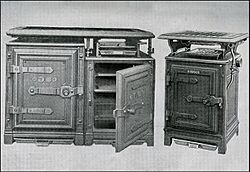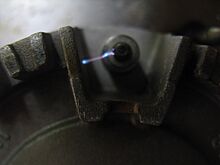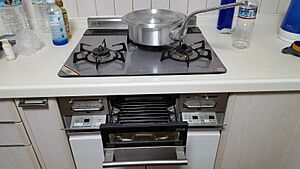Gas stove facts for kids
A gas stove is a kitchen appliance that cooks food using combustible gas. This gas can be natural gas, propane, or other types of flammable gas. Before gas stoves, people cooked on stoves that burned solid fuels like coal or wood.

The first gas stoves appeared in the 1820s. A factory making them opened in England in 1836. These new stoves were great because you could easily change the heat. You could also turn them off when not in use, saving fuel. However, gas stoves didn't become popular until the 1880s. By then, gas pipes were common in cities and towns in Britain. They became widely used in Europe and the United States in the early 1900s.
Gas stoves became even more common when the oven was built into the bottom. Their size also got smaller to fit better in kitchens. By the 1910s, makers started to enamel gas stoves. This made them much easier to clean.
At first, you lit the gas with a match. Later, a small, always-burning flame called a pilot light made it easier. But pilot lights used gas all the time. Ovens still needed to be lit with a match. If you turned on the gas without lighting it, gas could fill the room and cause an explosion. To prevent this, a safety device called a flame failure device was added. Most modern gas stoves now have electronic ignition. They also have automatic timers for the oven and extractor hoods to remove cooking fumes.
Gas stoves are common indoor appliances that use fossil fuels. They can create a lot of indoor air pollution. Because of this, good ventilation is important for healthy air. Gas stoves release pollutants like nitrogen dioxide. This can cause breathing problems and has been linked to more cases of asthma in children. Gas stoves also release methane. In 2022, research showed that methane leaks from gas stoves in the U.S. were like the greenhouse gas emissions from 500,000 cars. About 80% of this methane leaks when stoves are off, from tiny cracks in gas lines. In 2023, scientists found that burning gas in stoves can release benzene. Benzene is a chemical that can cause cancer, even at levels higher than in secondhand tobacco smoke.
Contents
History of Gas Stoves
The very first gas stove was created in 1802 by Zachäus Winzler. But this and other early tries were just experiments. James Sharp patented a gas stove in England in 1826. He opened a gas stove factory in 1836. His invention was sold by the company Smith & Philips starting in 1828.
A famous chef named Alexis Soyer helped people accept this new technology. From 1841, he changed his kitchen to use piped gas. He said gas was cheaper because you could turn it off when not cooking.
A gas stove was shown at the Great Exhibition in London in 1851. But it wasn't until the 1880s that gas stoves became a big success in England. By then, a large and reliable network of gas pipes covered much of the country. This made gas cheap and easy to use at home. Gas stoves only became common in Europe and the United States in the early 1900s.
Early gas stoves were quite large. But soon, the oven was built into the bottom. Their size got smaller to fit better with other kitchen furniture. By the early 1920s, gas stoves with easy-to-clean enameled surfaces were widely available. They also used a lot of insulation to save fuel.
In the 1960s, the American Gas Association ran ads to promote gas stoves. They also tried to play down science that showed health risks. This was similar to how the tobacco industry playbook tried to create doubt.
How Gas Stoves Ignite
Today's gas stoves use two main ways to light up: a standing pilot or electric ignition.
A stove with a standing pilot has a small, constant gas flame. This flame is usually under the cooktop, between the front and back burners. When you turn on the stove, this small flame lights the gas coming out of the burners. The good thing about this system is that it's simple. It doesn't need any outside power. A small downside is that the flame uses a little gas all the time, even when you're not cooking.
Older gas ovens didn't have a pilot light. You had to light them by hand with a match. If you accidentally left the gas on, gas would fill the oven and then the room. A tiny spark, like from turning on a light switch, could ignite the gas and cause a big explosion. To stop these accidents, oven makers added a safety valve called a flame failure device. This valve uses a sensor to make sure the flame is on. If the flame goes out, it shuts off the gas.
Most modern gas stoves have electronic ignition. This creates electric sparks to light the burners. You hear a "clicking sound" just before the burner lights. You start the sparks by turning the gas burner knob to "LITE" or by pressing an 'ignition' button. Once the burner lights, you turn the knob further to change the flame size. Some stoves have "auto reignition." This means you just turn the knob to the flame size you want. The sparking stops automatically when the flame lights. Auto reignition is also a safety feature. If the flame goes out (for example, from a gust of wind), it will automatically relight if the gas is still on. If the power goes out, you might need to light the burners with a match.
Electric ignition for ovens uses a "hot surface" or "glow bar" ignitor. This is a heating part that gets hot enough to light the gas. A sensor checks when the glow bar is hot enough and then opens the gas valve.
Gas Stove Features
Burner Heat Levels
One important thing about a gas stove is how much heat its burners can make. Burner heat is usually measured in kilowatts or British Thermal Units per hour. This shows how much gas is used, not how much heat goes into your pans.
Often, a gas stove will have burners with different heat levels. For example, a cooktop might have a high-heat burner (around 3 to 6 kilowatts). This is great for boiling a large pot of water quickly or for sautéing and searing food. It will also have medium-heat burners (1.5 to 3 kilowatts) and low-heat burners (1 kilowatt or less). The low-heat burners are good for simmering food slowly.
Some fancy cooktop models have very powerful burners. These can go up to 6 kilowatts or more. These are useful for cooking large amounts of food or for special cooking styles. However, these powerful burners create more emissions. This means you need better ventilation to keep the air safe.
Design and Layout
In recent years, stove makers have made cool changes to how gas stoves look and are set up. Most modern cooktops have a grate that covers the whole top. This lets you slide pots and pans from one burner to another without lifting them. Some modern gas stoves also have a fifth burner in the middle or a flat griddle built in.
Stove Size
The size of a kitchen gas stove usually ranges from 50 to 150 centimeters (about 20 to 60 inches). Many companies make stoves in different sizes. You can also get stoves that combine a cooktop and an oven. These usually come in two styles: "slide-in" and "freestanding."
Slide-in stoves have edges that overlap the countertop. Their controls are usually on the front. Freestanding stoves have solid sides and their controls are often at the back of the cooktop.
Oven Features
Many stoves have ovens built right in. Modern ovens often have a fan inside called a convection fan. This fan moves hot air around evenly, helping food cook better. Some modern ovens have temperature sensors. These let you control baking very closely. They can turn off automatically when a certain temperature is reached. Or they can keep a steady temperature during cooking. Some ovens even have two separate oven sections. This lets you cook two different dishes at the same time.
Programmable Controls
Many gas stoves now come with modern programmable controls. These make them easier to use. LCD screens and complex cooking programs are common features on most basic and high-end models. Other programmable controls include exact pre-heating, automatic pizza settings, and cooking timers.
Safety Features
Newer gas stoves are safer than older ones. Two main safety worries with gas stoves are child-safe controls and accidentally turning them on. Some gas cooktops have knobs that can be switched on too easily with a gentle bump.
Gas stoves can also be a risk when frying oil. The oil can get too hot and catch fire on the stove. Countries like Japan, South Korea, and China have rules for adding electronic safety devices to prevent pans from overheating. These devices use a sensor called a thermistor. It checks the temperature near the pan. If the heat gets too high, it cuts off the gas supply. After these safety devices were required in Japan in 2008, fewer house fires were caused by gas stoves.
Health and Climate Concerns
Health Risks
Gas stoves can release harmful gases into your home. These include Carbon monoxide, formaldehyde, benzene, and nitrogen dioxide. These gases can make the air inside your home unhealthy. Nitrogen dioxide can make breathing problems like asthma worse.
Many studies have looked at the link between gas stoves and asthma in children. A 2013 study found that cooking with gas increases the risk of asthma in children. A 2023 study estimated that in the United States, one out of every eight cases of asthma in children is due to pollution from gas stoves. The risk of asthma from gas stoves is similar to the risk from secondhand smoke from tobacco. Gas stoves can create levels of nitrogen dioxide that are higher than outdoor safety limits.
People use their stoves more directly than other gas appliances. This increases their exposure to natural gas chemicals and things made when gas burns. These include formaldehyde, carbon monoxide, and nitrogen oxides. Unlike other gas appliances, stoves release these directly into your home's air. They don't have to vent the fumes outside. Cooking, especially high-heat frying, also releases smoke and other harmful particles.
To reduce indoor pollution, you can use a range hood, open a kitchen window, or use an air purifier. Range hoods work better at catching pollution from back burners than front ones. California requires gas stoves to have better ventilation than electric stoves because of the nitrogen dioxide risk. You can run your range hood for 15 minutes after cooking to help clear the air.
A 2023 study found that benzene, a chemical known to cause cancer, built up in homes to unhealthy levels when natural gas or propane stoves were used. This was especially true when vent hoods were not used. The scientists found that benzene comes from the cooking gas itself, not the food. Benzene exposure can cause cancer and other health problems. Short-term exposure can affect blood cell production. Long-term exposure increases the risk of certain blood cancers.
Climate Impact
Gas stoves often run on natural gas. Getting and using natural gas is a growing cause of climate change. Both the gas itself (especially methane) and carbon dioxide (released when natural gas burns) are greenhouse gases. These gases trap heat in the Earth's atmosphere.
In 2022, a study looked at gas leaks in 53 homes. It estimated that methane leaks from gas stoves in the United States were equal to the greenhouse gas emissions of 500,000 cars over 20 years. About 80% of these methane leaks happen when stoves are turned off. This is due to tiny leaks in gas lines and fittings.
Some places, like the Australian Capital Territory and New York State, have stopped allowing gas stoves and appliances in new buildings. They do this for health, indoor air quality, and climate protection reasons. As of 2023, whether these bans are legal in the United States is being decided in court.
See also
- Auto reignition
- Electric stove
- List of stoves
Images for kids






